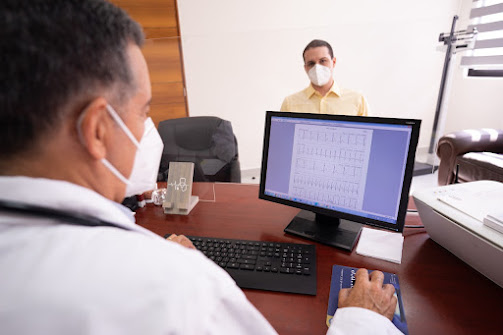DOCTORS & MEDICAL STUDENTS VERSION
Note: This protocol is a general guideline and should be
adapted to the specific policies and resources of your hospital. Always refer
to the latest clinical guidelines and consult with medical experts for accurate
information.
1. Introduction
This protocol outlines the steps to be followed by
healthcare professionals in the hospital setting for the management of patients
presenting with suspected or confirmed myocardial infarction (MI), commonly
known as a heart attack.
2. Pre-Hospital Preparedness
2.1. Establish a designated team for MI management,
including cardiologists, emergency physicians, nurses, and support staff.
2.2. Ensure the availability of necessary equipment and
medications in emergency departments and critical care units.
3. Patient Assessment
3.1. Immediate triage of patients with suspected MI based on
presenting symptoms (chest pain, discomfort, shortness of breath, etc.).
3.2. Perform a rapid clinical assessment, including vital
signs, medical history, and risk factors for heart disease.
4. Diagnosis Confirmation
4.1. Conduct an electrocardiogram (ECG) within 10 minutes of
patient arrival to assess for ST-segment elevation.
4.2. If ST-segment elevation is present, diagnose as ST-segment elevation myocardial infarction (STEMI). If absent, consider
non-ST-segment elevation MI (NSTEMI) or unstable angina.
5. Immediate Management
5.1. Notify the designated cardiac catheterization lab team
for STEMI cases.
5.2. Administer aspirin (chewable, 325 mg) and clopidogrel
(300 mg loading dose) or ticagrelor (180 mg loading dose).
5.3. Provide supplemental oxygen if oxygen saturation is
<90%.
5.4. Administer nitroglycerin sublingually or intravenously
to relieve chest pain.
6. Reperfusion Therapy for STEMI
6.1. Primary Percutaneous Coronary Intervention (PCI):
6.1.1. Initiate PCI
within 90 minutes of diagnosis.
6.1.2. Administer
unfractionated heparin or bivalirudin during PCI.
6.1.3. Insert an
intra-aortic balloon pump if indicated for hemodynamic stability.
6.2. Fibrinolytic Therapy (if PCI is not available within 120
minutes):
6.2.1. Administer
fibrinolytic therapy promptly after diagnosis.
6.2.2. Monitor for
bleeding complications.
7. Medical Management for NSTEMI/Unstable Angina
7.1. Administer antiplatelet agents (aspirin, P2Y12
inhibitors), anticoagulants, and nitroglycerin as appropriate.
7.2. Initiate beta-blockers, angiotensin-converting enzyme
inhibitors (ACEIs), or angiotensin receptor blockers (ARBs) based on the patient's
clinical status.
8. Monitoring and Complications
8.1. Continuously monitor cardiac rhythm, blood pressure,
and oxygen saturation.
8.2. Perform serial ECGs and cardiac enzyme tests (troponin)
to monitor for changes and infarct size.
8.3. Manage complications promptly, including arrhythmias,
heart failure, and cardiogenic shock.
9. Follow-up and Discharge Planning
9.1. Coordinate post-MI care, including cardiac
rehabilitation, lifestyle modifications, and medication adherence.
9.2. Provide patient education on symptoms, medications,
dietary changes, and when to seek medical attention.
10. Documentation and Communication
10.1. Maintain thorough and accurate medical records of all
assessments, interventions, and patient responses.
10.2. Facilitate clear communication among healthcare team
members and with patients/families regarding diagnosis, treatment, and
prognosis.
11. Quality Improvement and Education
11.1. Regularly review and update the protocol based on the
latest evidence and guidelines.
11.2. Conduct periodic training and drills to ensure staff
competence in MI management.
This protocol is intended to provide a general outline for
the management of myocardial infarction in a hospital setting. Always refer to
current clinical guidelines and collaborate with experienced medical
professionals to ensure the best patient care.








